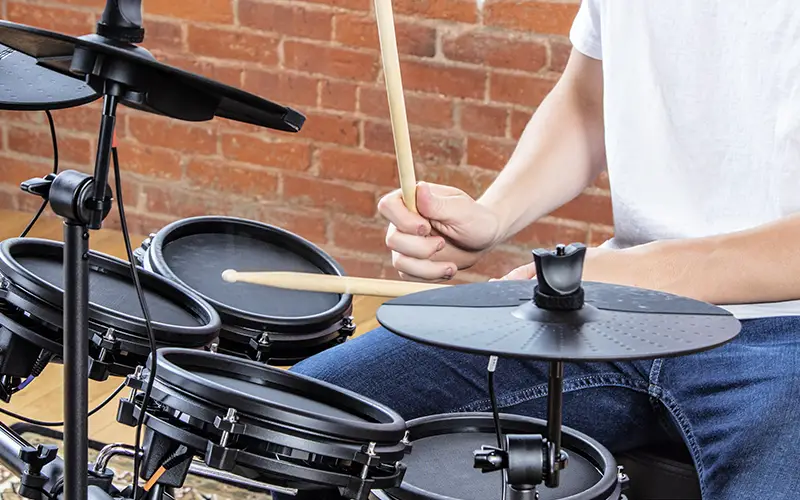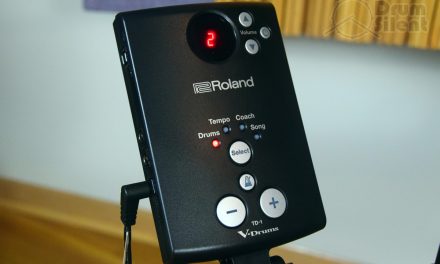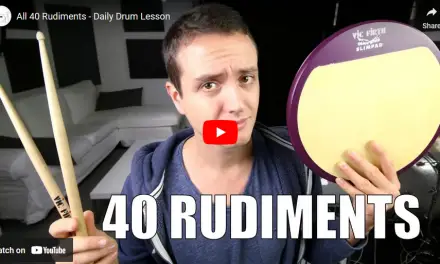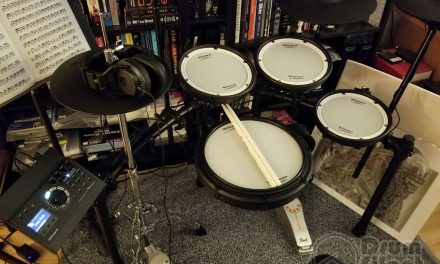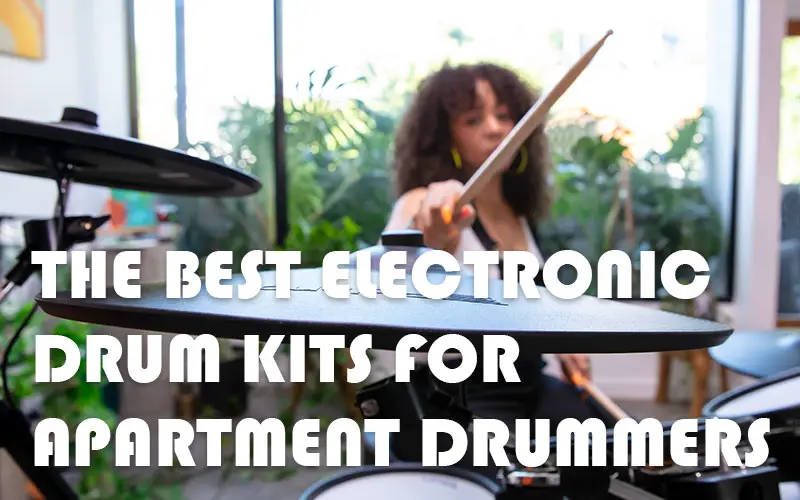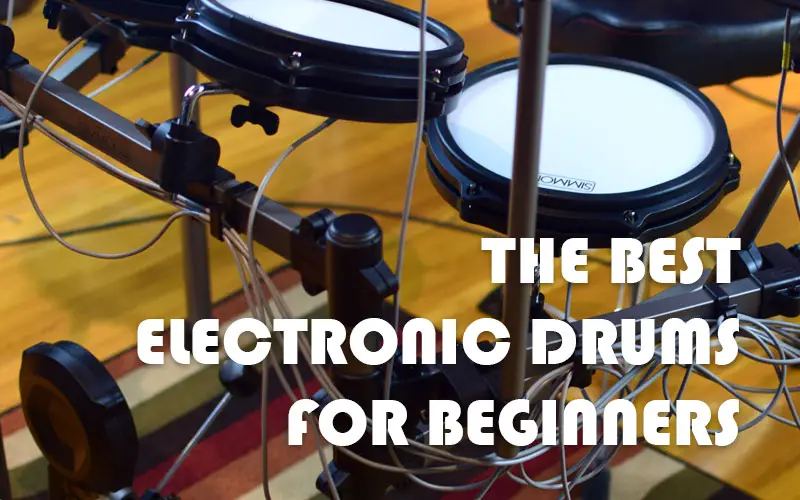Being a new drummer can be kind of intimidating when you start looking for some gear. There are just so many options these days, from acoustic drum kits to electronic kits and everything in between. Beginner drummers often just need something to work on rudiments and coordination, and anything else is a plus. Also, being able to jam with music you like is a good thing for beginners. Guess what fits those requirements? You got it – electronic drum kits.
First, Let Me Age Myself
If you are learning in a school environment, you will likely have the benefit of some gear to practice on. I remember when I was in high school, my friends and I would jam with the pep band trap set and the bass amp hidden behind the stage in the gymnasium. At the time none of us could afford our own gear beyond sticks and broken down guitars. It was what we had available and we made it work.
Now, here I am, more than 25 years later and I look at what’s out there for drums and for beginner drummers, and the electronic drum market really stands out so much more than it used to. Electronic drums weren’t really something you could find affordably, if at all. It was much more easy to find a beat up acoustic drum kit and start out with that.
But now it’s almost the opposite. There are some really great options for cheap electronic drum kits that are more affordable than their acoustic counterparts. The features and the play-ability of even the cheapest electronic drum kits is pretty amazing.
Let’s take a look at why an electronic drum kit is worth it for beginners.
Cheaper Electronic Drum Kits Are Low Risk
Looking at the current market, it’s entirely possible to buy a basic, brand new electronic drum kit for less than $500. Even closer to $300 in some instances. When you spend that amount of money these days, you are likely going to a get a kit with a mesh snare pad, at least two toms maybe three, a hi-hat, ride and crash cymbal, and some sort of kick pad. You’ll also get a sound module and rack. You might need to spend a little more on a kick pedal, throne and a pair of headphones.
A $500 investment for all that doesn’t seem bad at all. You can even go cheaper if you buy used gear.
Let’s say you start practicing drums and find out that you don’t like it or you end up finding out that you prefer playing guitar instead. You can sell off the drum gear you did buy for at least half of what you paid for it, maybe more. So you’ll only be out $250 or less. It’s rough math, but it checks out.
Practice Drums More Quietly
Beginner drummers will often need to set up their drum kits at home to practice regularly. An acoustic kit can be a very loud thing to have in your home. If you live with other people or have neighbors, they might have issues with the constantly loud noise associated with acoustic drums.
An electronic drum kit solves that problem. You will be able to put on headphones and keep the drum sounds to yourself. Your housemates might still be able to hear you tapping on the drum pads, but it will be a lot more tolerable than the sound of an acoustic drum kit.

Electronic Drum Kits Offer More Sound Variety for the Money
An advantage that electronic drum kits will have over similarly priced acoustic kits is the availability of a variation of sounds. If you are a new drummer, it can be a lot more exciting to be able to switch the sounds of the kit to better match the style of music you are practicing. The sound modules on even the cheaper drum kits will offer a variety of drum kits and drum sounds to play with.
In order to change the sound of an acoustic kit you need to buy more gear. Want a new snare sound? Buy another snare or different heads. Want different cymbal sounds? Buy more cymbals. Changing the sound of an acoustic drum kit can get expensive fast, and is not generally feasible or advisable for beginners.
Less Space Required
Cheaper electronic drum kits that are meant for beginners typically have a smaller footprint and are pretty lightweight. They don’t take up much space and can be moved around easily. Acoustic kits will generally take up more space, although some can get pretty compact. When you are in your beginner stages you most likely are practicing at home more, and space in the home can be a premium. A compact electronic drum kit can be more reasonable in that situation and won’t take up much more space than a desk or a loveseat.
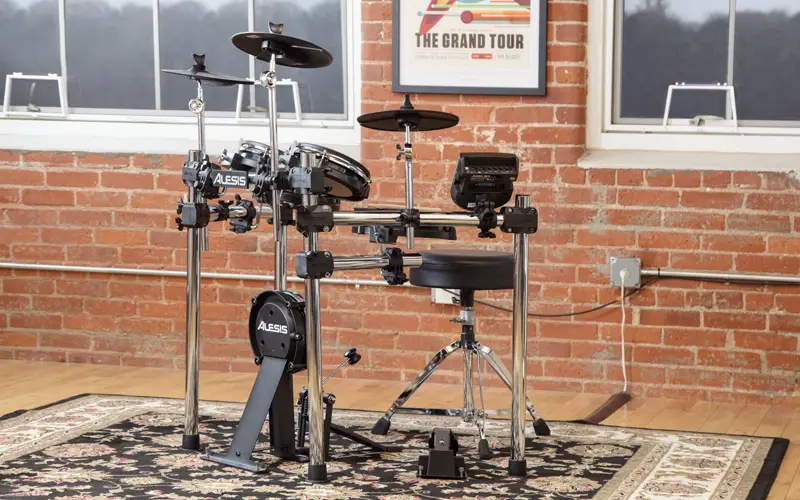
Find Your Footing as a Drummer
The flexibility to try different drum kit sounds allows you to learn what types of drum sounds you like. As a beginner drummer you’ll also spend time playing along with music you like or experimenting playing along with different styles of music. You’ll learn how you like to play, you’ll learn what you do and don’t like about your cheap electronic drum setup, and most importantly you’ll have a much better idea of what type of drums will fit your developing style and approach when you decide to upgrade as you get better.
Once you get more solid footing as a drummer in terms of knowing what sounds you like and how you like to play, it makes it a lot easier to decide on what type of acoustic kit you’ll want when you get to that point. A good acoustic drum kit can be more of an investment and it’s good to have a better idea of what type of drummer you are and what type of sound you like so that you can confidently purchase the right kit for you and your style when you get there.
Recording Electronic Drums Can Be Easier
Even though you might be a beginner drummer, you may soon arrive at a point where you want to record yourself playing the drums, either to analyze your progress or to maybe even work on musical projects.
As a beginner, recording an electronic drum kit will be a lot easier than trying to record an acoustic drum kit.
To record your electronic drum kit you just need to plug the audio outputs into an audio interface on a computer or connect via MIDI to a computer. If you record via MIDI, you can easily fix or quantize your drum parts when you make mistakes and also replace your sounds easily. You can also use any number of drummer apps or plugins out there such as Superior Drummer or EZ Drummer to make it sound like you were playing on studio-recorded acoustic kits.
With an acoustic kit the recording process can get a lot more complicated very quickly. You’ll need multiple mics, multi-input recording interfaces, good sounding drums and a good sounding room, not to mention the knowledge to properly mic and mix everything.
Potential Drawbacks of Using an Electronic Drum Kit as a Beginner
Of course we need to touch on some drawbacks as well. An electronic drum kit will have a different feel than an acoustic kit, especially when you compare the cheaper electronic kits to a good acoustic kit.
Generally, the pad sizes will be smaller than acoustic drum sizes, which creates a smaller hit target. This could be a positive though, since playing on smaller pads will require you to develop more precise striking techniques.
Cheaper electronic drum kits might not have very advanced cymbal pads and might lack things like a bell zone on the ride and different sounds when playing the edge and the bow of the cymbal. For this reason it can be trickier to learn how to dynamically play cymbals on a cheaper electronic kit.
It can be hard to learn how to do cross-sticking and proper rim shots on a cheaper electronic kit since the pads don’t typically have those features at lower price levels.
An electronic drum kit might not give you an accurate representation of how the finer dynamics of drum sounds can work on an acoustic kit. Harder vs softer strikes might not have as much of a dramatic volume or tonal difference on cheaper electronic kits vs acoustic kits. Ghost notes or rolls might not sound as good on a cheap electronic kit vs an acoustic. But you have to consider the level you are at. If you are beginner these things might not matter as much until you get your drum chops further developed.
Conclusion
As you can see, there’s some arguments both in favor of electronic drums or against electronic drums for beginners. What’s our general opinion?
We think electronic drum kits are definitely worth it for beginners, and in most cases might be the best option.
They are easier to keep quiet, they are affordable, they offer lots of sound options and they don’t take up much space. It’s much more reasonable to set up an electronic drum kit in a bedroom, office or living room than an acoustic kit when you are just starting out as a drummer. And if you’re drum kit is set up in a place where you spend a lot of time, you’ll practice a lot more and develop your skill much more quickly.
We wouldn’t recommend staying on electronic drums forever, it’s good to branch out and start playing on an acoustic kit when you are able. But it’s going to be much easier to start on electronic drums for most people.
Recommended Electronic Drum Kits for Beginners
When recommending drum kits for beginners, we like to stick to kits that have a little better action on the snare drum pad even if the cymbal lineup has some shortcomings. We also prefer drum kits that use standard kick pedals.
We feel that a combination of a good feeling kick and snare can really make a cheaper drum kit more enjoyable to play and practice on, even if some of the other pads have shortcomings – which they will at lower budget levels.
Take a look at our recommended electronic drum kits for beginner drummers for more.

